A Weighted EFOR Algorithm for Dynamic Parametrical Model Identification of the Nonlinear System
Abstract
:1. Introduction
2. Modeling Framework—The NARX-M-for-D
3. The Weighted EFOR (WEFOR) Algorithm
3.1. Traditional EFOR Algorithm
3.2. Evaluation of the Final NARX-M-for-D
4. Validation of the WEFOR Algorithm
4.1. The Numerical Illustrative Example
4.2. Experimental Verification
5. Conclusions
Author Contributions
Funding
Institutional Review Board Statement
Informed Consent Statement
Data Availability Statement
Acknowledgments
Conflicts of Interest
References
- Qin, Z.Y.; Han, Q.K.; Chu, F.L. Analytical model of bolted disk-drum joints and its application to dynamic analysis of jointed rotor. Proc. Inst. Mech. Eng. Part C J. Mech. Eng. Sci. 2014, 228, 646–663. [Google Scholar] [CrossRef]
- Akinola, T.E.; Oko, E.; Gu, Y.; Wei, H.; Wang, M. Non-linear system identification of solvent-based post-combustion CO2 capture process. Fuel 2019, 239, 1213–1223. [Google Scholar] [CrossRef]
- Sidorov, D.; Muftahov, I.; Tomin, N.; Karamov, D.; Panasetsky, D.; Dreglea, A.; Foley, A.A. Dynamic Analysis of Energy Storage With Renewable and Diesel Generation Using Volterra Equations. IEEE Trans. Ind. Inform. 2020, 16, 3451–3459. [Google Scholar] [CrossRef] [Green Version]
- Zhu, Y.; Lang, Z.Q. A new convergence analysis for the Volterra series representation of nonlinear systems. Automatica 2020, 111, 108599. [Google Scholar] [CrossRef]
- Csurcsia, P.Z.; Peeters, B.; Schoukens, J. User-friendly nonlinear nonparametric estimation framework for vibro-acoustic industrial measurements with multiple inputs. Mech. Syst. Signal Pract. 2020, 145, 106926. [Google Scholar] [CrossRef]
- Birpoutsoukis, G.; Csurcsia, P.Z.; Schoukens, J. Efficient multidimensional regularization for Volterra series estimation. Mech. Syst. Signal Pract. 2018, 104, 896–914. [Google Scholar] [CrossRef] [Green Version]
- Haryanto, A.; Hong, K.S. Maximum likelihood identification of Wiener-Hammerstein models. Mech. Syst. Signal Pract. 2013, 41, 54–70. [Google Scholar] [CrossRef]
- Liu, Y.; Bai, E. Iterative identification of Hammerstein systems. Automatica 2007, 43, 346–354. [Google Scholar] [CrossRef]
- Wills, A.; Schon, T.B.; Ljung, L.; Ninness, B. Identification of Hammerstein-Wiener models. Automatica 2013, 49, 70–81. [Google Scholar] [CrossRef] [Green Version]
- Leontaritis, I.J.; Billings, S.A. Input-output parametric models for non-linear systems Part I: Deterministic non-linear systems. Int. J. Control 1985, 41, 26. [Google Scholar] [CrossRef]
- Leontaritis, I.J.; Billings, S.A. Input-output parametric models for non-linear systems Part II: Stochastic non-linear systems. Int. J. Control 1985, 41, 329–344. [Google Scholar] [CrossRef]
- Ayala Solares, J.R.; Wei, H. Nonlinear model structure detection and parameter estimation using a novel bagging method based on distance correlation metric. Nonlinear Dynam. 2015, 82, 201–215. [Google Scholar] [CrossRef]
- Rashid, M.T.; Frasca, M.; Ali, A.A.; Ali, R.S.; Fortuna, L.; Xibilia, M.G. Nonlinear model identification for Artemia population motion. Nonlinear Dynam. 2012, 69, 2237–2243. [Google Scholar] [CrossRef]
- Ge, X.B.; Luo, Z.; Ma, Y.; Liu, H.P.; Zhu, Y.P. A novel data-driven model based parameter estimation of nonlinear systems. J. Sound Vib. 2019, 453, 188–200. [Google Scholar] [CrossRef]
- Bayma, R.S.; Zhu, Y.P.; Lang, Z.Q. The analysis of nonlinear systems in the frequency domain using Nonlinear Output Frequency Response Functions. Automatica 2018, 94, 452–457. [Google Scholar] [CrossRef]
- Billings, S.A. Nonlinear System Identification: NARMAX Methods Nonlinear System Identification: NARMAX Methods in the Time, Frequency, and Spatio-Temporal Domains; John Wiley & Sons: Chichester, UK, 2013. [Google Scholar]
- Wei, H.L.; Lang, Z.Q.; Billings, S.A. Constructing an overall dynamical model for a system with changing design parameter properties. Int. J. Model. Identif. Control 2008, 5, 93–104. [Google Scholar] [CrossRef]
- Zhu, Y.; Lang, Z.Q. Design of Nonlinear Systems in the Frequency Domain: An Output Frequency Response Function-Based Approach. IEEE Trans. Contr. Syst. Technol. 2017, 99, 1–14. [Google Scholar] [CrossRef] [Green Version]
- Liu, H.; Zhu, Y.; Luo, Z.; Wang, F. Identification of the dynamic parametrical model with an iterative orthogonal forward regression algorithm. Appl. Math. Model. 2018, 64, 643–653. [Google Scholar] [CrossRef]
- Piroddi, L.; Spinelli, W. An identification algorithm for polynomial NARX models based on simulation error minimization. Int. J. Control 2003, 76, 1767–1781. [Google Scholar] [CrossRef]
- Billings, S.A.; Wei, H. Sparse Model Identification Using a Forward Orthogonal Regression Algorithm Aided by Mutual Information. IEEE Trans. Neural Netw. 2007, 18, 306–310. [Google Scholar] [CrossRef] [PubMed]
- Guo, Y.; Guo, L.Z.; Billings, S.A.; Wei, H. An iterative orthogonal forward regression algorithm. Int. J. Syst. Sci. 2015, 46, 776–789. [Google Scholar] [CrossRef]
- Liu, Y.; Li, J.; Wang, T.; Ding, Y.; Wang, G. Study on the friction resistance calculation method of a flexible shaft of wire rope based on genetic algorithm. Mech. Adv. Mater. Struc. 2021, 1–15. [Google Scholar]
- Wei, H.L.; Zheng, Y.; Pan, Y.; Coca, D.; Li, L.M.; Mayhew, J.E.; Billings, S.A. Model estimation of cerebral hemodynamics between blood flow and volume changes: A data-based modeling approach. IEEE Trans. Biomed. Eng. 2009, 56, 1606–1616. [Google Scholar]
- Liu, H.; Zhu, Y.; Luo, Z.; Han, Q. PRESS-based EFOR algorithm for the dynamic parametrical modeling of nonlinear MDOF systems. Front. Mech. Eng. 2018, 13, 390–400. [Google Scholar] [CrossRef]
- Wolberg, J. Data Analysis Using the Least-Squares Method; Springer: Berlin/Heidelberg, Germany, 2006. [Google Scholar]
- Favier, G.; Kibangou, A.Y.; Bouilloc, T. Nonlinear system modeling and identification using Volterra-PARAFAC models. Int. J. Adapt. Control 2012, 26, 30–53. [Google Scholar] [CrossRef] [Green Version]
- Benabdelwahed, I.; Mbarek, A.; Bouzrara, K.; Garna, T. Non-linear system modelling based on NARX model expansion on Laguerre orthonormal bases. IET Signal Process 2018, 12, 228–241. [Google Scholar] [CrossRef]
- Ghosh, S.; Maka, S. Genetic algorithm based NARX model identification for evaluation of insulin sensitivity. Appl. Soft Comput. 2011, 11, 221–226. [Google Scholar] [CrossRef]
- Chen, Q.; Worden, K.; Peng, P.; Leung, A.Y.T. Genetic algorithm with an improved fitness function for (N)ARX modelling. Mech. Syst. Signal Pract. 2007, 21, 994–1007. [Google Scholar] [CrossRef]
- Ma, Y.; Liu, H.; Zhu, Y.; Fei, W.; Zhong, L. The NARX Model-Based System Identification on Nonlinear, Rotor-Bearing Systems. Appl. Sci. 2017, 7, 911. [Google Scholar] [CrossRef]
- Brake, M.R.W. The Mechanics of Jointed Structures; Springer: Berlin/Heidelberg, Germany, 2018. [Google Scholar]


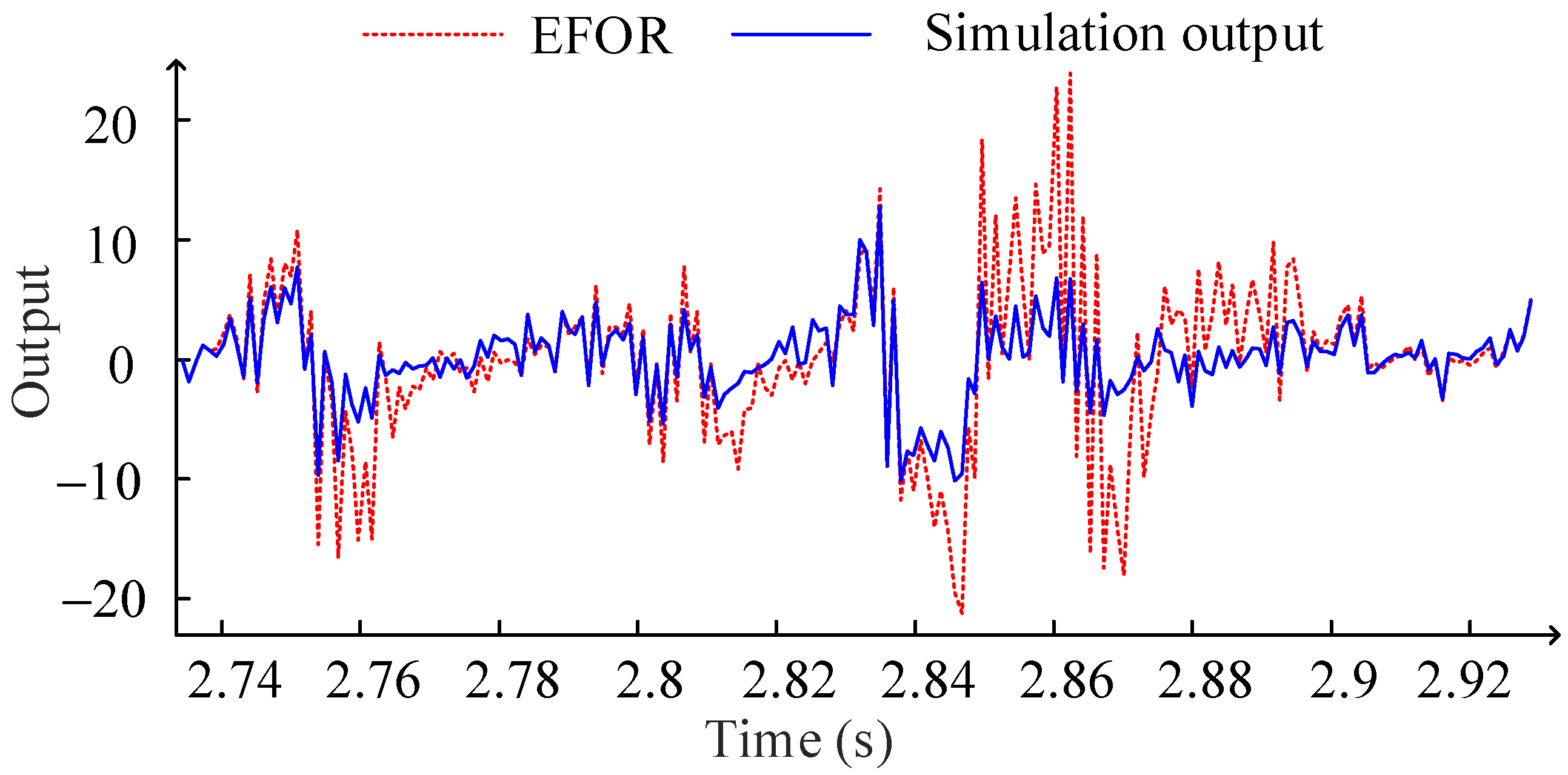

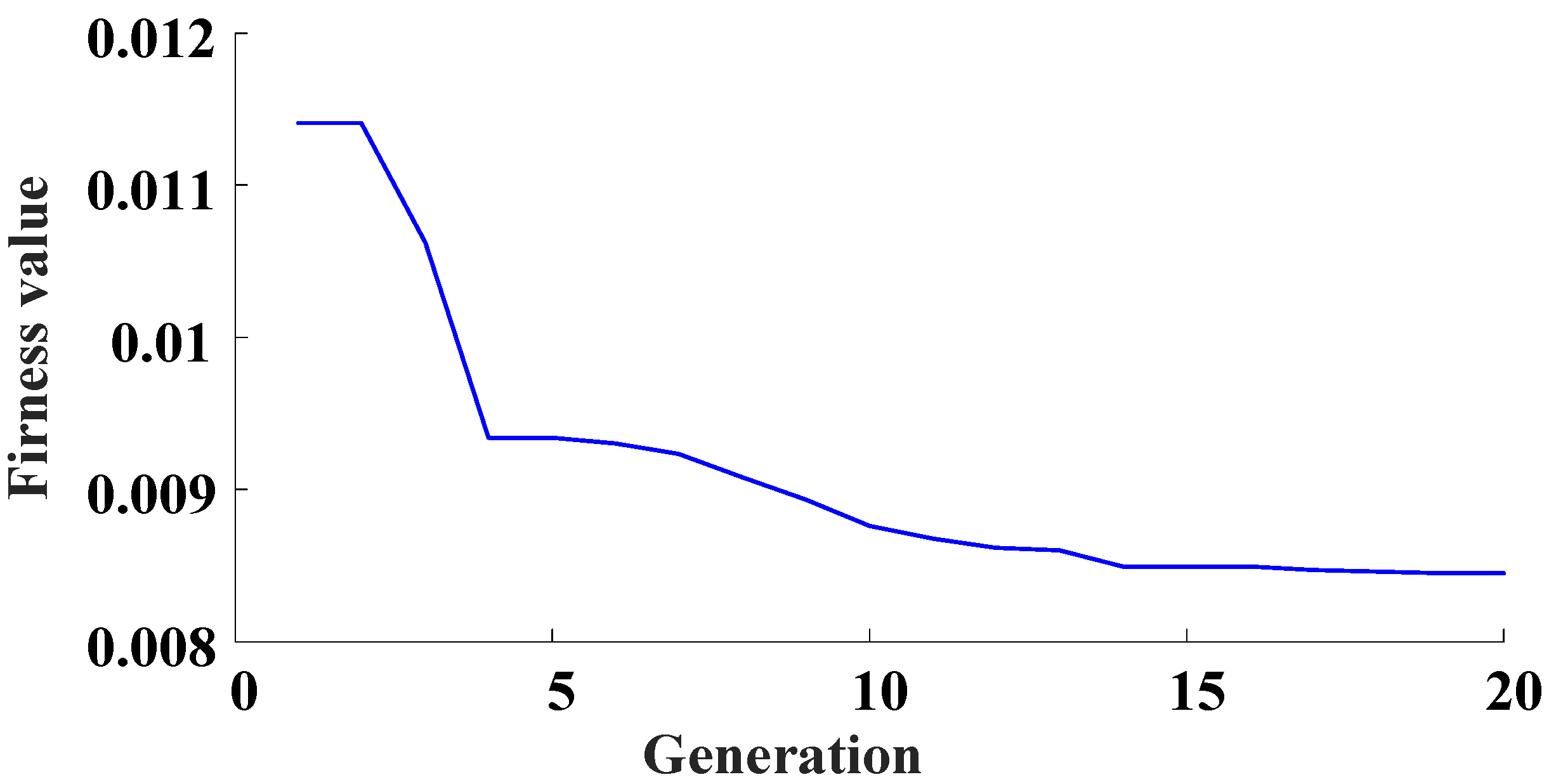
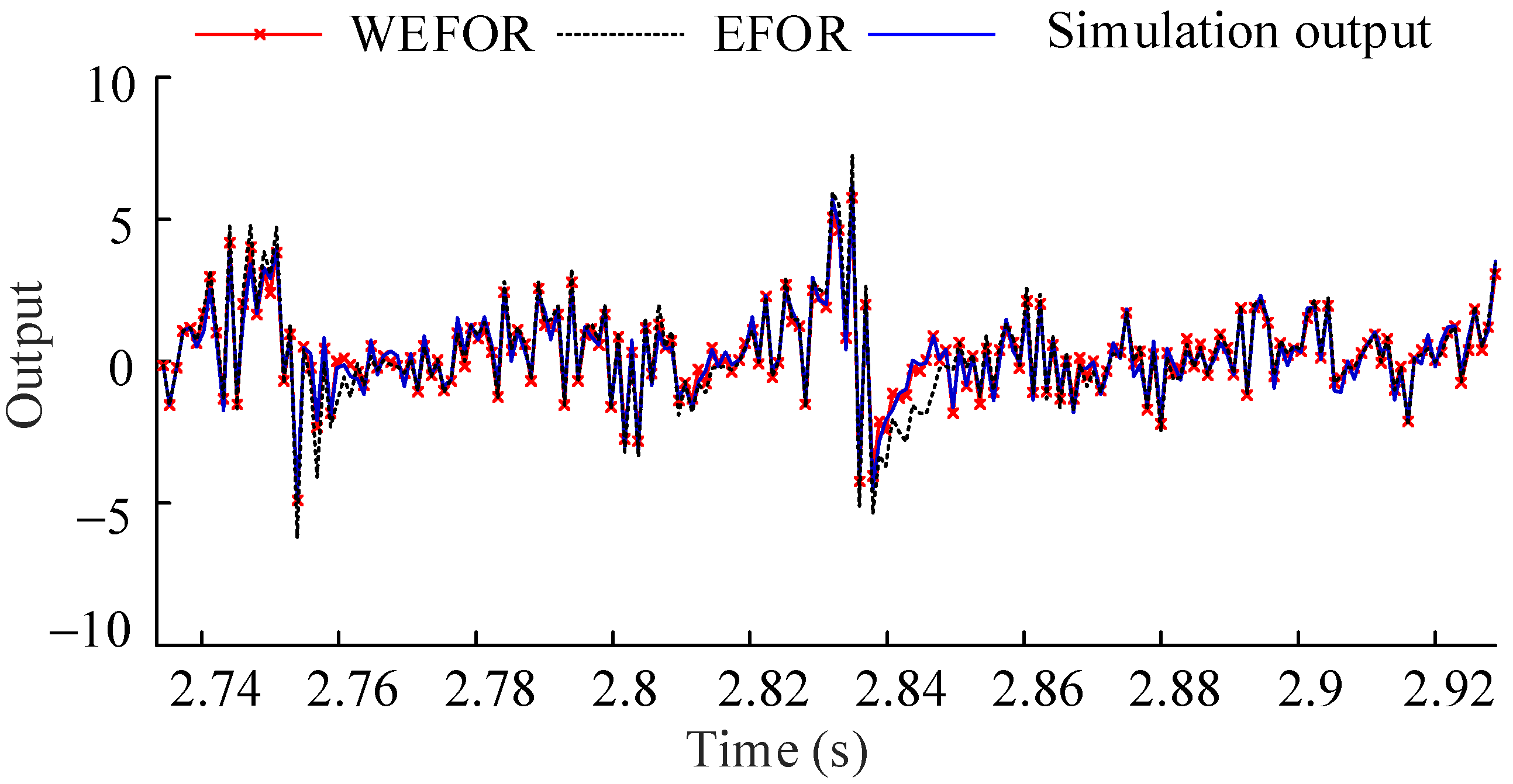


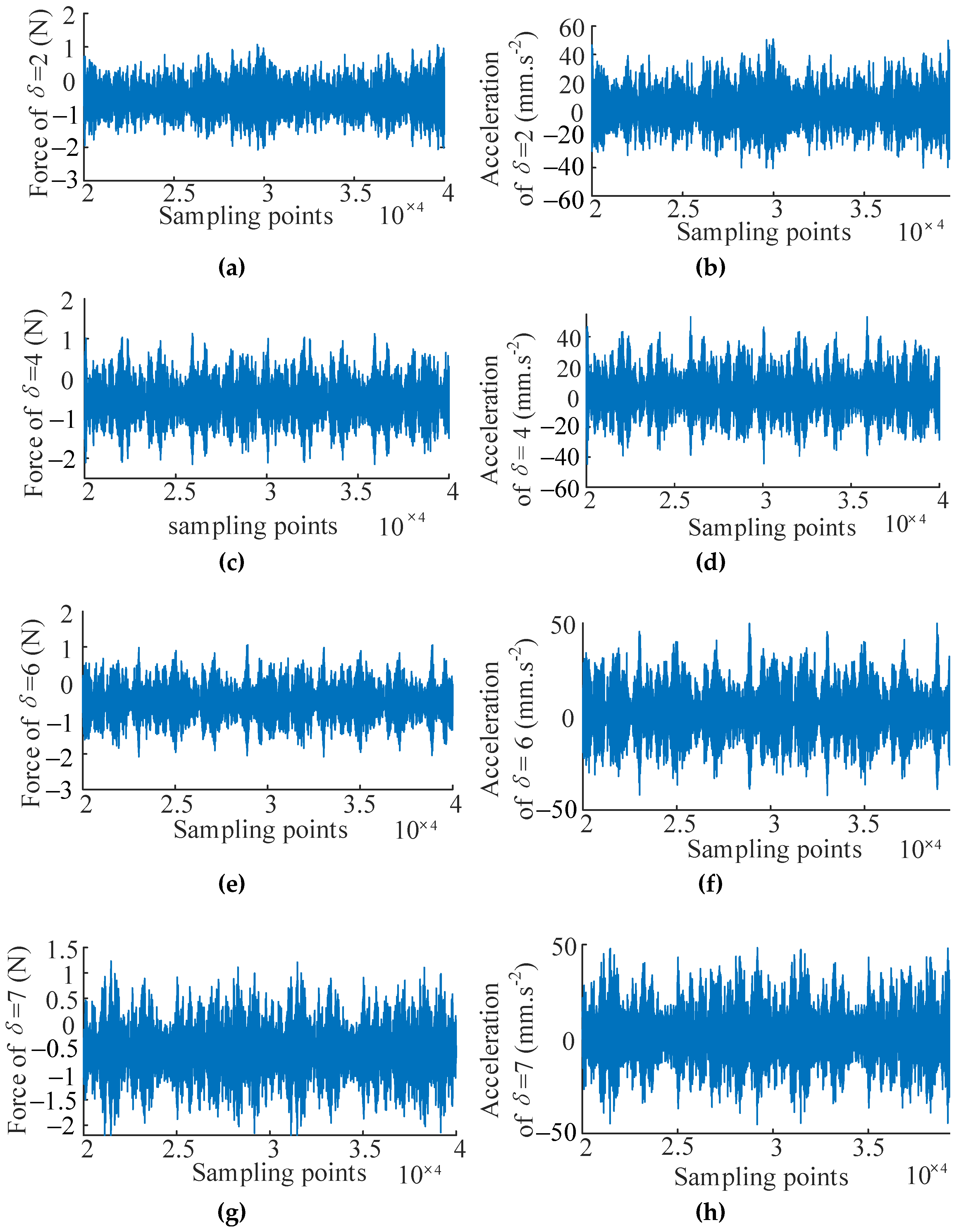




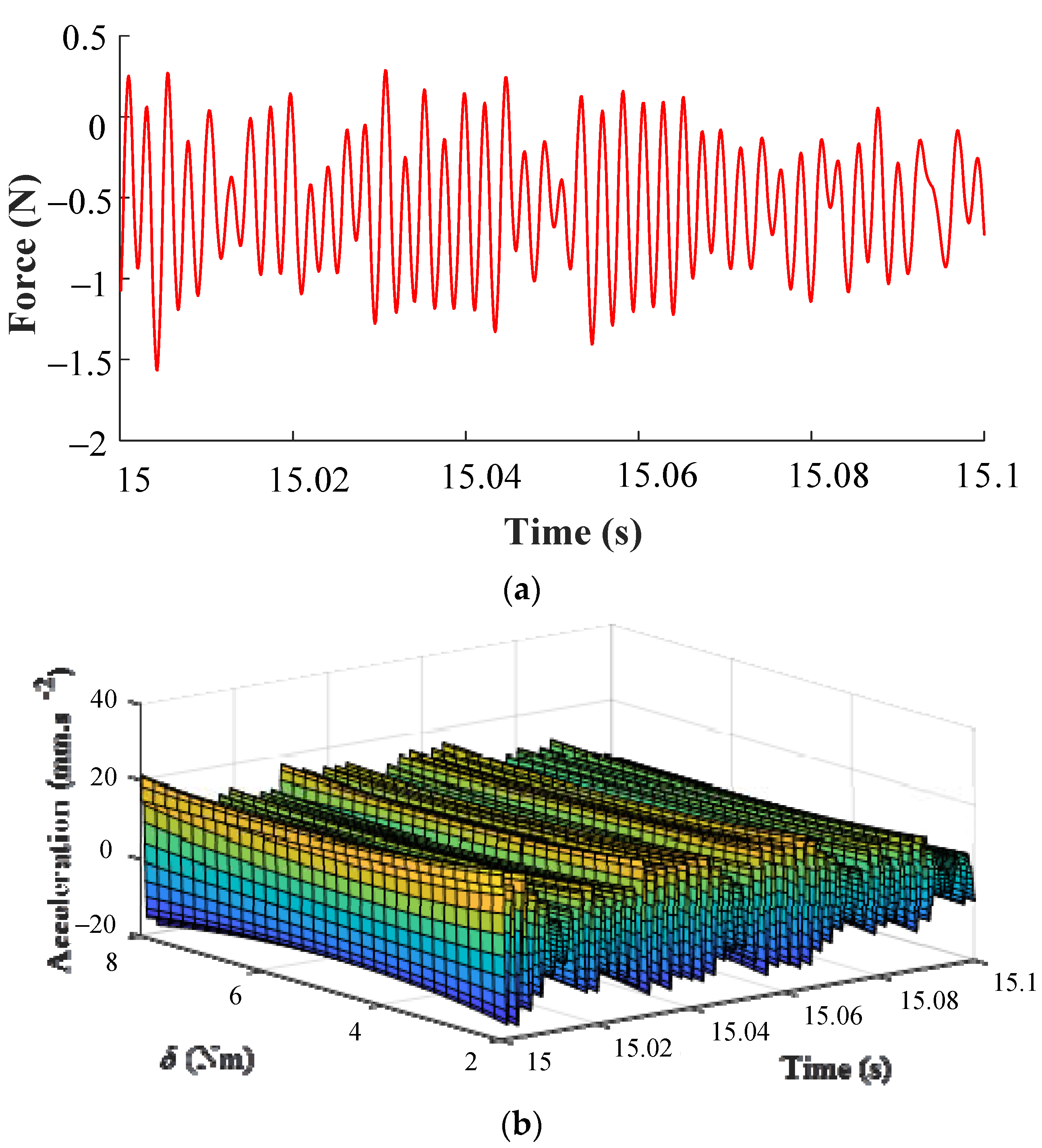
| Step | Term | Coefficients for Different Design Parameter Values | AERR (%) | ||
|---|---|---|---|---|---|
| φ = 2 | φ = 4 | φ = 6 | |||
| 1 | u(t − 1) | 0.05337 | 0.20775 | 0.50488 | 69.05 |
| 2 | u(t − 2)2 | 0.06466 | 0.12820 | 0.27330 | 26.56 |
| 3 | u(t − 1)y(t − 3) | 0.09095 | 0.22194 | 0.44975 | 2.98 |
| 4 | y(t − 2) | 0.03640 | 0.08289 | 0.17207 | 1.08 |
| 5 | y(t − 1) | 0.01205 | 0.02580 | 0.05619 | 0.12 |
| Total | 99.80 | ||||
| φ = 9 | φ = 10 | |
|---|---|---|
| EFOR | 0.08996 | 0.39294 |
| WEFOR | 0.03613 | 0.02506 |
| Step | Term | Coefficients for Different Design Parameter Values | AERR (%) | ||
|---|---|---|---|---|---|
| δ = 2 Nm | δ = 4 Nm | δ = 6 Nm | |||
| 1 | y(t − 1) | 2.4571 | 2.3883 | 2.3563 | 91.98 |
| 2 | y(t − 2) | −2.1348 | −2.0344 | −1.9764 | 7.91 |
| 3 | y(t − 3) | 0.6376 | 0.5913 | 0.5602 | 5.89 × 10−2 |
| 4 | u(t − 3) | 11.5313 | 10.8823 | 11.2157 | 5.67 × 10−3 |
| 5 | 1 | 0.1413 | 0.144 | 0.1627 | 1.39 × 10−3 |
| 6 | u(t − 1) | 12.2887 | 12.0533 | 12.6782 | 6.26 × 10−4 |
| 7 | u(t − 2) | −23.6811 | −22.839 | −23.7511 | 4.58 × 10−3 |
| 8 | u(t − 2)2y(t − 3) | −0.0023 | −0.0014 | −8.36 × 10−4 | 3.34 × 10−5 |
| 9 | u(t − 1)y(t − 1)2 | 2.51 × 10−5 | −5.24 × 10−5 | −8.58 × 10−5 | 1.53 × 10−5 |
| 10 | u(t − 1)2 | 0.0102 | −0.0021 | 0.0355 | 7.61 × 10−6 |
| Total | 99.96 | ||||
| i | j | |||
|---|---|---|---|---|
| 0 | 1 | 2 | 3 | |
| 1 | 2.5625 | −61.89 | 4.587 × 103 | 55.045 |
| 2 | −2.2778 | 82.125 | −5.314 × 103 | −63.779 |
| 3 | 0.6993 | −34.671 | 1.912 × 103 | 22.992 |
| 4 | 13.1629 | −1.06 × 103 | 1.228 × 105 | 1.47 × 103 |
| 5 | 0.1547 | −10.7183 | 2.009 × 103 | 24.113 |
| 6 | 13.385 | −762.99 | 1.075 × 105 | 1.29 × 103 |
| 7 | −26.277 | 1.7367 × 103 | −2.193 × 105 | −2.63 × 103 |
| 8 | −0.0037 | 0.8008 | −54.306 | −0.6517 |
| 9 | 1.47 × 10−4 | −0.0717 | 5.5013 | 0.066 |
| 10 | 0.0725 | −43.593 | 6.238 × 103 | 74.852 |
| δ = 7 | δ = 8 | |
|---|---|---|
| EFOR | 0.0389 | 0.0975 |
| WEFOR | 0.028 | 0.0724 |
Publisher’s Note: MDPI stays neutral with regard to jurisdictional claims in published maps and institutional affiliations. |
© 2021 by the authors. Licensee MDPI, Basel, Switzerland. This article is an open access article distributed under the terms and conditions of the Creative Commons Attribution (CC BY) license (https://creativecommons.org/licenses/by/4.0/).
Share and Cite
Li, Y.; Yang, D.; Wen, C. A Weighted EFOR Algorithm for Dynamic Parametrical Model Identification of the Nonlinear System. Processes 2021, 9, 2113. https://doi.org/10.3390/pr9122113
Li Y, Yang D, Wen C. A Weighted EFOR Algorithm for Dynamic Parametrical Model Identification of the Nonlinear System. Processes. 2021; 9(12):2113. https://doi.org/10.3390/pr9122113
Chicago/Turabian StyleLi, Yuqi, Dayong Yang, and Chuanmei Wen. 2021. "A Weighted EFOR Algorithm for Dynamic Parametrical Model Identification of the Nonlinear System" Processes 9, no. 12: 2113. https://doi.org/10.3390/pr9122113
APA StyleLi, Y., Yang, D., & Wen, C. (2021). A Weighted EFOR Algorithm for Dynamic Parametrical Model Identification of the Nonlinear System. Processes, 9(12), 2113. https://doi.org/10.3390/pr9122113






